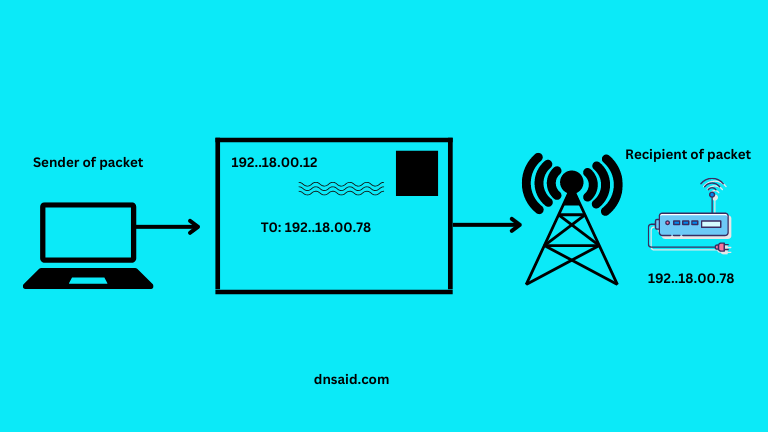The Internet Protocol (IP) serves as the fundamental framework for routing and addressing data packets across networks, ensuring efficient and accurate data transmission. When data is sent over the Internet, it is broken down into smaller units called packets. Each packet contains not only a portion of the data but also important IP information that includes the source and destination IP addresses. This addressing system allows routers, which are specialized devices in the network or , to determine the most efficient path for each packet to travel. As packets move through various routers and networks or domain, the IP information guides them, enabling them to reach their final destination accurately.
Once these packets arrive at their intended destination, they need to be reassembled and processed. This is where transport protocols like TCP (Transmission Control Protocol) and UDP (User Datagram Protocol) come into play. TCP ensures reliable delivery by establishing a connection between the sender and receiver and verifying that all packets have arrived intact and in the correct order. On the other hand, UDP allows for faster transmission without establishing a connection, which is useful for applications like video streaming where speed is more critical than perfect accuracy. Together, IP and these transport protocols form the backbone of Internet communication, allowing diverse devices and applications to communicate seamlessly and reliably.
What is a Network Protocol?
A network protocol is a set of rules and conventions that determine how data is transmitted and received across a network. These protocols ensure that devices from different manufacturers and operating systems can communicate with each other seamlessly. Network protocols cover a wide range of functions, including data formatting, error handling, authentication, and signaling. Common network protocols include IP (Internet Protocol), TCP (Transmission Control Protocol), and HTTP (HyperText Transfer Protocol). Each protocol has a specific role: IP handles the addressing and routing of data packets, TCP ensures reliable data transmission, and HTTP governs the transfer of web pages.
Network protocols are essential for the interoperability and functionality of modern networks. They provide a structured framework that allows for the exchange of data across local and wide-area networks, including the internet. For instance, when you send an email, multiple network protocols work together to ensure the email is properly formatted, addressed, transmitted, and received. The email client uses SMTP (Simple Mail Transfer Protocol) to send the message to an email server, which then uses IMAP (Internet Message Access Protocol) or POP3 (Post Office Protocol) to deliver it to the recipient’s client. This coordinated effort, governed by standardized protocols, ensures that the email is delivered accurately and efficiently, regardless of the devices or networks involved. Network protocols thus form the backbone of all networked communication, enabling the vast array of services and applications that rely on seamless data exchange.
What is IP address? How does it work?

An IP address is a unique identifier assigned to each device connected to a network that uses the Internet Protocol for communication. It serves as the address that enables devices to locate and communicate with each other across the internet or other networks. An IP address is typically written as a series of numbers separated by periods (IPv4) or colons (IPv6). For instance, an IPv4 address might look like 192.168.1.1, Via DNS resolvers, while an IPv6 address could be something like 2001:0db8:85a3:0000:0000:8a2e:0370:7334. These addresses are essential for routing data to the correct destination, ensuring that information sent from one device reaches the intended recipient.
IP addressing works through a hierarchical system, which includes different levels of networks and sub-networks. When a device is connected to a network, it is assigned an IP address either dynamically by a DHCP (Dynamic Host Configuration Protocol) server or statically by manual configuration. The IP address consists of two main parts: the network portion and the host portion. The network portion identifies the specific network to which the device is connected, while the host portion identifies the specific device within that network. Routers use the network portion of the IP address to forward data packets to the appropriate network, and once within the correct network, the host portion directs the packet to the exact device. This hierarchical structure allows for efficient routing and ensures that data can travel across multiple networks to reach its final destination.
IPv4 vs. IPv6
IPv4 and IPv6 are two versions of the Internet Protocol used to assign unique addresses to devices on a network, allowing them to communicate with each other.
IPv4 (Internet Protocol Version 4):
- IPv4 is the fourth version of the Internet Protocol and has been in use since the early 1980s.
- It uses a 32-bit address scheme, which allows for a total of approximately 4.3 billion unique addresses. An IPv4 address is typically written in decimal format, divided into four octets, separated by periods, e.g., 192.168.1.1.
- Due to the growing number of internet-connected devices, the IPv4 address space has been largely exhausted, leading to the development of IPv6.
- IPv4 includes features such as subnetting, which allows large networks to be divided into smaller, more manageable sub-networks, and NAT (Network Address Translation), which helps conserve IP addresses by allowing multiple devices on a local network to share a single public IP address.
IPv6 (Internet Protocol Version 6):
- IPv6 is the sixth version of the Internet Protocol, designed to replace IPv4 and address its limitations, particularly the shortage of addresses.
- It uses a 128-bit address scheme, providing a virtually limitless number of unique addresses (approximately 3.4 x 10^38 addresses). An IPv6 address is written in hexadecimal format, divided into eight groups, separated by colons, e.g., 2001:0db8:85a3:0000:0000:8a2e:0370:7334.
- IPv6 includes several enhancements over IPv4, such as simplified header structures for improved routing efficiency and built-in security features like IPsec (Internet Protocol Security) for end-to-end encryption and authentication.
- It also supports auto-configuration, which simplifies the process of assigning IP addresses to devices and eliminates the need for NAT, as the vast address space can accommodate direct addressing for every device.
What is an IP packet?
An IP packet is a formatted unit of data carried by a packet-switched network such as the Internet. It consists of two main components: the header and the payload.
- Header:
- The header contains essential information required for routing and delivering the packet to its destination.
- It includes fields such as the source and destination IP addresses, which indicate where the packet is coming from and where it is going.
- Other fields in the header may include the version of the IP protocol (IPv4 or IPv6), the length of the packet, the identification number, flags, fragment offset, time-to-live (TTL), protocol, and a checksum for error-checking.
- Payload:
- The payload is the actual data being transported, which can be part of a larger message or file that has been broken into smaller pieces for transmission.
- This data could be anything from a simple text message to a chunk of a video file, depending on the application or service using the network.
When an IP packet is sent from one device to another, it travels through various routers and networks. Each router examines the destination IP address in the header and determines the best path to forward the packet. If the packet is too large to pass through a particular network segment, it may be fragmented into smaller packets, which are then reassembled at the destination.
Redefine your trading strategies with solutions from elon musk ai platform. Real-time analytics ensure smarter investment decisions. Begin your journey to consistent success now.

